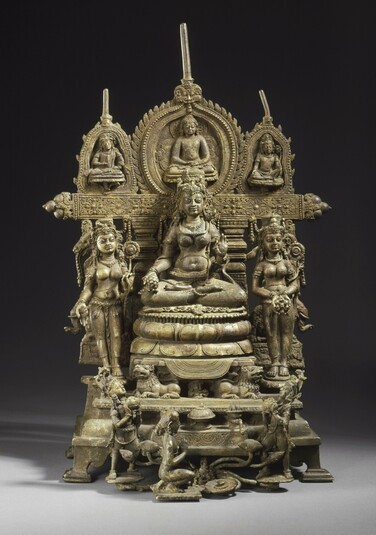
Item: Tara (Buddhist Deity) - (Unidentified)
| Origin Location | India |
|---|---|
| Date Range | 700 - 799 |
| Lineages | Buddhist |
| Material | Metal |
| Collection | Los Angeles County Museum of Art |
Classification: Deity
Appearance: Peaceful
Gender: Female
Tara accompanied by retinue figures, Naga Kings and a donor figure. This is only a tentative identification. LACMA sometimes describes this subject as a form of Chunda or Vasudhara. So far, there has been no universally accepted proof as to the identity of this female figure. (See the sculpture on the LACMA page).
(See HAR #7682 a Manjushri sculpture likely by the same artist or workshop).
At the top center is Amitabha Buddha, seated with the hands in the gesture of meditation. Above his head is a kirtimukha symbol (face of glory). On the viewer's left is a peaceful figure of Vajrapani holding a vajra scepter at the heart with the right hand. On the right side is Lokeshvara holding a lotus flower, with the proper left knee raised up.
At the center of the composition is a female figure, most likely a form of the goddess Devi Tara, with one face and two hands. The proper right hand is extended in a gesture of generosity across the right knee holding a large lobed fruit. The left hand is upraised in a gesture of salute or blessing. Typically with Tara she would be pressing together either the thumb and first finger or the thumb and ring finger together. Here the hand is open with all four fingers and thumb raised upward. She is seated with the two legs in vajra posture atop a double lotus seat and lion supported throne.
The two standing attendant figures are currently unidentified and have no commonly recognized characteristics to aid in an identification. To the right of Tara is a standing female attendant with the right hand extended downward with the palm open. The left hand holds the stem of a lotus flower blossoming over the left shoulder. At the proper left side of Tara is another standing female attendant holding with both hands in front of the lower torso a large jewel. Entwined up the left arm is the stem of a flower blossoming over the left shoulder. On the top of the head, in front of the bundle of hair, is a chaitya (stupa) crown ornament. This is a highly unusual object to be on the head of a female retinue figure. Typically it is only the bodhisattva Maitreya that bears the mark of the chaitya on the crown of the head. Both figures hold identical looking flowers blossoms, wear similar attire and have unusual chain belts around the waist.
In front of the throne are two Naga Kings with hoods of serpents above the head. They both hold bowls of offerings upraised with both hands. The figure on the viewer's left wears a chain belt while the King on the right wears a different, non-chain, style of belt. On a narrow table extending in front of the throne there are three offering bowls of varying size and function. The enter bowl has a large round lid and the container alongside has a handle and down turning grip typical of hand held incense burners.A donor figure in front, male, with long hair and a beard, kneels with the proper right knee raised. Lotus flowers, leaves and twisting stems adorn the front of the throne.
Within the literature structures of Buddhism, Tara belongs to the Tantra section. Within the Kriya Tantra Classification there are three Buddha Families: Tatagata, Padma and Vajra. The Padma Family has Amitayus (Amitabha) as the Buddha. The bodhisattva Avalokiteshvara is the Lord of the Family and the goddess Tara is the Mother of the Family.
With this sculpture, Amitabha Buddha is located at the top center directly above the head of the central figure. This most likely indicates that the central female figure is a form of Tara and that it is related to wealth and fruition. The presence of the two Naga Kings at the lower front likely indicates the wish for a good rainy season which would bring about an abundance of crops and a good harvest. Naga serpents are associated with rivers, underground waters and wells, along with the rains and the rainy monsoon season.
Jeff Watt 4-2017
Buddhist Deity: Tara (Sculpture, non-standard iconography)
Thematic Sets
Sculpture: Famous Works
Sculpture: Single/Multiple Figure Configuration
Sculpture: Figurative, Three Parts
Buddhist Deity: Tara (Miscellaneous Iconography Masterworks)
Collection of Los Angeles County Museum (Sculpture Masterworks)
Sculpture: Physical Characteristics
Buddhist Deity: Tara Main Page
Sculpture: Indian Atelier Comparison (8th Century)
Collection of Los Angeles County Museum (India, Sculpture Masterworks)
Buddhist Deity: Tara, Sculpture (Masterworks, Miscellaneous)

